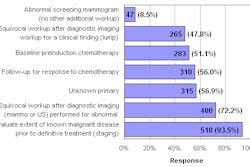There are two basic requirements for successfully submitting a medical claim for procedures and services: a unique identifying code and a corresponding published value. Furthermore, there are two kinds of primary identifying codes, CPT (Current Procedural Terminology) I and CPT III, as well as a Medicare-specific code, HCPCS (HCFA Common Procedure Coding System). Most radiology practices are familiar with CPT I codes, but not all understand the potential value of CPT III codes.
|
CPT code FAQs Does obtaining a CPT I code guarantee reimbursement from Medicare? No, Medicare first evaluates the CPT I code on the basis of medical necessity; then, if needed, it considers the proposed values recommended by the AMA-Specialty Society RVS Update Committee.
Does obtaining a CPT I code guarantee reimbursement from private payors? No, private payors are not obligated to pay for a CPT I code (or for a Medicare covered benefit, for that matter). Are there different AMA applications when submitting for a CPT I code or a CPT III code? No, the application is exactly the same. Does the RVS Update Committee always assign values to CPT I codes? No, there have been occasions when the RVS Update Committee assigned zero values to a CPT I code. Are CPT III codes permanent? No, they "sunset" in five years, requiring the transition to a CPT I code. How many CPT III codes have transitioned to CPT I codes? According to Desiree Rozell, senior coding specialist at the AMA, "since the inception of Category III codes (2002), roughly 39 Category III codes have been converted to CPT Category I codes." Can you obtain a CPT III code without clearance from the FDA? It is possible if the FDA clearance is imminent, but conventional wisdom would dictate that the procedure needs to have FDA clearance prior to receiving a CPT III code. What's the difference between a CPT I and CPT III code? In a nutshell, a CPT III code lacks broad-based utilization and published prospective studies on its effectiveness. Just how long does it take to obtain a CPT I code? Provided the AMA receives the application no later than July 23, 2008, and if the process is successful, a CPT I code would be fully implemented January 1, 2010. How long does it take to get a CPT III code? Once again, provided the application is received by July 23, 2008, and the process is successful, a CPT III code would be released January 1, 2009, and fully implemented July 1, 2009. |
Using Category III codes when they are available is critical to the evaluation of healthcare delivery and the formation of public and private policy. These codes are intended for use in data collection purposes to substantiate widespread use of a technology, as well as in the U.S. Food and Drug Administration (FDA) approval process.
Category III CPT codes differ from the usual CPT code requirements in the following ways:
- Services or procedures must be performed by many healthcare professionals across the U.S.
- FDA approval must be documented or be imminent within a given CPT cycle.
- The service or procedure must have a proven clinical efficacy.
Category III CPT codes' reimbursement potential
As mentioned, according to the AMA, CPT III codes allow for data collection for the respective service or procedure to demonstrate extensive usage of a technology.
Does this mean, then, that CPT III codes are not reimbursed? The 2008 Medicare Hospital Outpatient Prospective Payment System (HOPPS) document states that CPT III codes can be reimbursed, and that of the 129 listed CPT III codes, 57 are assigned to an ambulatory payment classification with a published reimbursement rate. In other words, 44% of the currently listed CPT III codes are being reimbursed under the 2008 HOPPS. However, the Medicare Physician Fee Schedule Database (MPFSDB) tells a different story. In the 2008 MPFSDB, none of the CPT III codes listed have been assigned a relative value unit.
Why do the Centers for Medicare and Medicaid Services seem to embrace CPT III codes on the HOPPS but not on the MPFSDB? The answer lies in the AMA description.
Category III CPT codes are not referred to the AMA-Specialty Society RVS Update Committee for valuation because no relative value units are assigned. Payment for these services or procedures is based on the policies of payors rather than on a yearly fee schedule: It is Medicare's custom to list CPT III codes on the MPFSDB as "carrier priced," which means the decision to cover these services or procedures is at the discretion of the contracted Medicare carriers. The lack of published relative value units does not prohibit payment for these services by the local Medicare providers or private payors, but the lack of published values does represent a significant problem for CPT III codes.
What's the problem with CPT III codes?
An estimated 70% of all payors utilize the MPFSDB as a basis for their reimbursement strategies. Most providers also use the MPFSDB to develop charges for the services and procedures provided. The lack of published relative value units makes the development of reimbursement charges difficult for CPT III codes, as there are no common published reference values for the services or procedures.
This problem is compounded by the fact that most claims are filed and adjudicated electronically. Eighty-five percent of all physician practices process claims electronically, according to industry expert estimates. The lack of published relative value units makes the electronic processing of CPT III claims nearly impossible. Still, there is a remedy for this situation.
Medicare has not deemed all services and procedures medically necessary for their beneficiaries -- there are plenty of services and procedures not covered by Medicare that are reimbursed by private payors. Therefore, private payors rely on published non-Medicare relative value units to adjudicate non-Medicare covered services and procedures.
In order for a CPT III code to be reimbursed, it needs a published non-Medicare relative value unit. There are a number of companies that publish complete listings of both Medicare and non-Medicare relative value units for use by providers and physicians, including Relative Value Studies' "The Complete RBRVS" and Ingenix's "Essential RBRVS."
Making a CPT III code more productive
Publishing a non-Medicare relative value unit for a CPT III code might seem to be a daunting task. But it is simplified to some degree when one utilizes the published HOPPS reimbursement values. There are three components to the Medicare relative value units: technical, professional, and global. The HOPPS value applies to the technical fee of the relative value unit. In order to obtain a global relative value unit, a professional relative value unit would need to be developed.
There are two methods for determining a professional fee. The first method -- and the easiest -- is to use a predicate technology's relative value unit. In the absence of a predicate technology, a survey can be developed similar the one the RVS Update Committee uses. The professional relative value unit, added to the technical relative value unit, equals the global relative value unit. Current examples of non-Medicare relative value units published for CPT III codes include 0084T, 0174T, and 0175T.
There is no question that a CPT I code is recognized as the gold standard for reimbursement, but there are still no guarantees for payment. A CPT III code, although not as prestigious as a CPT I code, is far superior to no code at all. Obtaining a CPT I code requires a significant amount of time compared to the acquisition of a CPT III code, making a CPT III code an attractive alternative for reimbursement.
The current business situation for radiology makes it almost impossible to acquire new technology unless it has some potential for reimbursement. A CPT III code is an acceptable alternative provided it acquires published non-Medicare relative value units.
By Michael Longacre
AuntMinnie.com contributing writer
August 7, 2008
Michael Longacre is a principal with HealthCare Market Strategies, a Yamhill, OR, consulting firm that facilitates the early adoption of new technologies by addressing reimbursement issues.
Related Reading
Reimbursement 101: How vendors can help you get paid, August 24, 2007
Deficit Reduction Act Survival Kit, Part 3 -- Growing the business, August 7, 2007
Deficit Reduction Act Survival Kit, Part 2 -- Attaining operating excellence, July 30, 2007
Deficit Reduction Act Survival Kit, Part 1 -- Leading your imaging center, July 23, 2007
DRA takes bite out of GE's Q2 numbers, July 16, 2007
Copyright © 2008 AuntMinnie.com



















